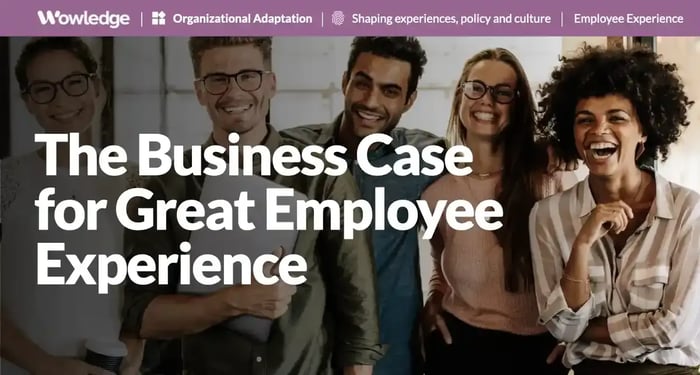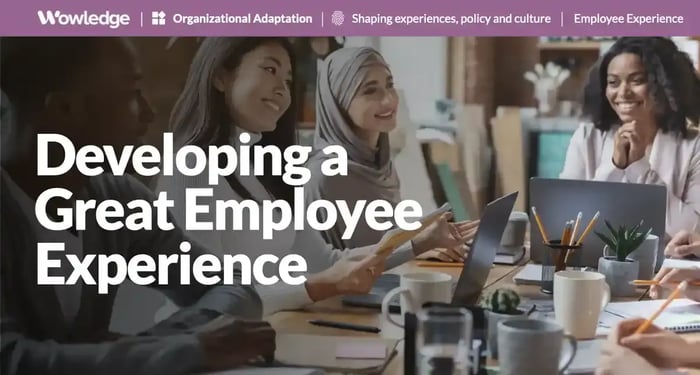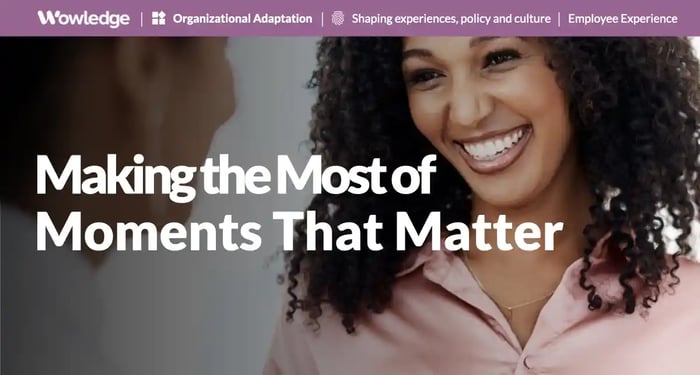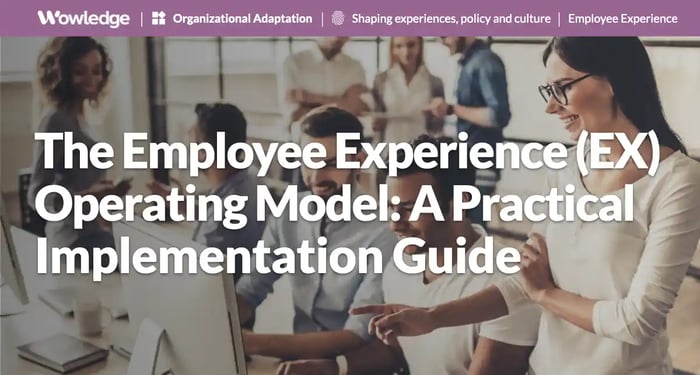Table of Contents
Given the ongoing turmoil in labor markets and even with changes in job growth, the competition for talent is not easing. Projections indicate that there is more than enough new job creation to cover any layoffs. How can companies continue to compete? What can and should they attend to? The answers lie in developing and managing a compelling and high-value employee experience (EX).
EX refers to the cumulative interactions, perceptions, and feelings that employees encounter throughout their employment lifecycle journey with an organization. It includes all the aspects of employees’ interactions with their work environment, including the physical workspace, company culture, relationships with colleagues and managers, opportunities for growth and development, and the overall support provided by the organization.
Employee Experience focuses on understanding and improving the employee's overall well-being, engagement, and satisfaction at work. It recognizes that employees are not just resources but individuals with unique needs, aspirations, and motivations. By creating a positive employee experience for each employee, organizations aim to foster a work environment that promotes productivity, engagement, and a sense of purpose. Much of that is determined using a set of disciplined and deliberate employee listening techniques, such as those leveraged in design thinking.
Design thinking collects insights and analyzes data from employees on not just their experiences interacting with the employment processes, people, and ecosystems, but on those places in the “journey” (e.g., from new hire to alumni or retiree) that have the most impact on their satisfaction, motivation and engagement as a part of the employee population. Those “moments that matter” become targets for experiential improvement through redesign, in ways that enhance the efficiency, effectiveness, or impact of the process, program, or interaction. Potential targets for the journey that contribute to a positive employee experience include:
- Company Culture: The values, norms, and behaviors that shape the organization's work environment, including the level of trust, inclusivity, and recognition of employee contributions.
- Leadership and Management: The quality of leadership, management practices, and the effectiveness of communication and decision-making processes within the organization.
- Career Development and Growth: Opportunities for professional development, learning, skill enhancement, and advancement within the organization.
- Work-Life Balance: The ability to achieve a healthy balance between work responsibilities and personal life, including flexibility in working hours, location, and support for personal well-being.
- Employee Recognition and Rewards: Acknowledgment and appreciation of employee contributions through recognition programs, rewards, and a fair compensation structure.
- Collaboration and Teamwork: The extent to which employees are encouraged to collaborate, share knowledge, and work together effectively to achieve common goals.
- Employee Support and Wellness: The provision of resources, support programs, and initiatives that promote employee well-being, both physical and mental.
- Technology and Tools: The availability and usability of technology and tools that enable employees to perform their tasks and access needed resources efficiently and effectively.
- Physical Environment: The workplace location, design, amenities, and comfort level of the physical space where employees perform their tasks.
When focusing on enhancing the employee experience, organizations aim to create a positive and engaging work environment that attracts and retains talent, drives productivity, and ultimately contributes to the success and growth of the business.
What is the observed or projected value of focusing on employee experience?
At a practical level, focusing on employee experience (EX) can bring benefits and create significant value for organizations. Here are some key aspects of value to both business and talent outcomes of prioritizing employee experience:
1. Enhanced productivity
When employees have a positive experience at work, they tend to be more engaged, motivated, and satisfied. This, in turn, should boost their productivity and efficiency, leading to improved business outcomes. Engaged employees are more likely to go the extra mile, collaborate effectively, and take ownership of their work, resulting in higher levels of productivity and better overall performance.
2. Increased talent attraction and retention
A strong focus on employee experience can make the organization an attractive place to work, helping in the attraction and retention of top talent. In today's competitive job market, talented professionals are increasingly seeking organizations that provide a positive work environment, growth opportunities, and a healthy work-life balance. By investing in employee experience, a company can differentiate itself from its competitors, leading to increased retention rates and a higher caliber of candidates applying for (and accepting) positions.
3. Reduced turnover costs
High employee turnover can be costly for businesses owing to recruitment, onboarding, and training expenses, loss of productivity, as well as the loss of institutional knowledge. By prioritizing employee experience, organizations can create a supportive and fulfilling workplace, reducing turnover rates. When employees feel valued and supported, they are more likely to stay with the company for the long term, leading to cost savings and improved continuity.
4. Greater innovation and creativity
Positive employee experiences tend to foster a culture of innovation and creativity within organizations. When employees feel empowered, trusted, and encouraged to share their ideas, they become more willing to contribute innovative solutions and take calculated risks. By promoting an environment that values and rewards creative thinking, companies can tap into their employees' full potential, leading to improved problem-solving, innovation, and competitive advantage.
5. Improved customer satisfaction
Employee experience and customer experience (CX) are interconnected. Satisfied and engaged employees are believed to be more likely to deliver exceptional customer service, resulting in higher levels of customer satisfaction. Employees who feel supported and empowered are similarly motivated to provide better service, understand customer needs, and go above and beyond to meet expectations. This positive correlation between employee experience and customer satisfaction can lead to increased customer loyalty, positive word-of-mouth referrals, and improved business performance.
6. Stronger employer brand and reputation
A focus on employee experience contributes to building a strong employer brand and positive reputation in the market. Satisfied employees often become brand advocates, sharing their positive experiences with others, including potential customers and job seekers. A positive reputation as an employer of choice not only attracts top talent but also enhances the overall brand perception, which can have a positive impact on customer acquisition and business growth.
Prioritizing employee experience is posited to lead to enhanced productivity, improved talent attraction and retention, reduced turnover costs, a culture of innovation, increased customer satisfaction, and a strong employer brand. These benefits contribute to a more successful and sustainable business in the long run. The question is, are the pundits who promote this supported by real experience and data?

What the data tells us about the ROI of great EX
Measuring the return on investment (ROI) of employee experience (EX) can be challenging due to its intangible nature. However, organizations can still assess the value of EX initiatives by examining various metrics and indicators. Leveraging research and robust measurement offers insights into the true and more objective impacts of a great employee experience. To that end, data suggests that it can have significant impacts on:
Profitability and revenue enhancement
A recent study in Harvard Business Review reported that a large global retailer whose stores moved from the bottom quartile to the top quartile in each of the employee experience metrics studied would increase their revenue by more than 50%, and profits by nearly as much. It found that if an average store could move from the bottom quartile of performance to the top quartile in each of the four EX dimensions it would go from generating $57 per person-hour worked to $87 per person-hour. Willis Towers Watson found that those companies with a robust EX strategy and program achieved a 7% difference in three-year change in gross profit margin. And MIT research has found that companies in the top quartile on employee experience generate 25% higher profitability than their competitors.
Employee engagement
Data suggests that the stronger the EX, the higher the employee engagement and satisfaction levels are with their employer. The aforementioned study by Willis Towers Watson found that employers consider EX as a key driver of employee engagement (81%), well-being (80%), productivity (79%) as well as overall business performance (78%). Another related study of employee perceptions found that during the pandemic employee perceptions of management’s level of care for their well-being dropped from 72% to 57%. As a result, it reported that 43% of companies said that actions taken by employers during the pandemic had a negative impact on the employee experience.
However, those employers who employed a formal EX strategy experienced higher/improved organizational culture (+44%), employee experience (+40%), employee engagement (+35%) and employee wellbeing (+28%) Furthering that point, a 2021 LinkedIn/Glint study found that employees who were satisfied with just a single element of EX (flexibility in hours or location) were 3.4 times more likely to successfully balance work and personal obligations, 2.6 times more likely to be happy working for their employer, and 2.1 times more likely to recommend working for their employer.
Turnover rates
Much has been said, researched, and written about why employees leave their jobs, and their experiences with management, the workplace, work policies, job design, and development and growth opportunities are all major experiences that tend to matter most. The Willis Towers Watson study found that the top 9% of companies (those with a formal and successful EX strategy) were 90% more likely to report lower annual turnover than their industry peers. And the American Psychological Association reports that “very few employees would leave an organization” when they perceive that leadership was fully invested in their experience, and 89% would recommend their workplace to others. Similarly, an IBM study reported by Forbes found that while only 21% of employees would leave a company with great EX, nearly 50% reported their intention to leave those companies with low EX.
Productivity and performance
Proposed or theorized impacts of positive EX on individual and team performance metrics tend to be born out in the research. Willis Towers Watson found that those companies with robust employee experience strategies realized a 2.7x higher productivity than their industry peers. Forbes’ report on the IBM study found that employees in high EX companies expended 95% of their discretionary effort for their company’s benefit, whereas low EX company employees used it only at a 55% level.
Customer satisfaction
Higher employee satisfaction and engagement often lead to improved customer service and experiences, which can result in increased customer loyalty, repeat business, and positive word-of-mouth referrals. In fact, the MIT research mentioned above found that those companies in the top quartile of employee experience enjoy over twice (2X) the customer satisfaction levels of their industry counterparts, as measured by net promoter scores (NPS).
Innovation
Given that employees in their definition of high EX enjoyed greater access to collaborative and needed technologies plus having ready access to other’s expertise and ideas, MIT’s research reported that companies with the highest EX experienced more than twice (2X) the rate of innovation in the prior two years compared to those at lower levels. Their percentage of revenues that came from new products and services introduced was 51% versus 24% for lower EX companies.
Recruitment and talent acquisition
Looking at the experience of job seekers (candidate experience) is the initial phase of EX and can have a direct impact on the quality of candidates attracted to the organization and subsequent new hires. Even if the organization has a positively viewed employee value proposition (EVP), the initial step of being recruited can impact the perception of employee experience. SoftwareAdvice surveyed active job seekers and found that 83% who had a negative application experience would never reapply and that 59% would tell others not to apply. They also found that not only would 88% of those with a positive experience tell others to apply, but 71% would purchase the company’s products even if they did not receive a job offer. Recruiter.com reported that a positive and efficient application process can increase application conversion rates by up to 365 percent. Additionally, shorter cycle times for the recruitment process and job offers yielded 40% more offer acceptances. Finally, it suggests that regular and strengthened communications with candidates yield improvements in the quality of hires.
While it may be challenging to assign a precise monetary value to employee experience, a comprehensive evaluation of these metrics can provide insights into the overall impact and ROI of EX initiatives. Additionally, conducting regular surveys, collecting both quantitative and qualitative process and feedback data, and engaging in conversations with employees can provide valuable information on their perceptions and experiences, allowing organizations to continuously improve their EX strategies.
Nonetheless, research provides ample support to the notion and power of providing an exceptional employee experience that stretches from “cradle to grave” to attract and retain highly engaged and productive talent. The use of employee listening and engagement systems, including surveys, design thinking processes, and outcome analytics, can bring both objective and useful insights that create an environment where the employee employment journey can be extended and optimized.
Relevant Practices & Tools
Emerging HR Strategy Practices for Engaging Employees and External Partners Now and Into the Future. >
At its most sophisticated level, HR Strategy defines a future centered around optimizing how employees and their needs are managed and how critical external resources and relationships can best be leveraged to effectively drive productivity, retention, and business results... more »
Creating an Employee Experience that Bonds High Performers to the Organization. >
The employee experience constitutes the entire journey an employee takes with the organization. This includes everything from pre-hire to post-exit interactions and everything in between... more »
Using Human-Centered Design to Build Employee and Customer-Focused Innovation Initiatives. >
Human-centered design is an approach to innovation that grounds any initiative (service, program, or product) in real human needs by engaging the end-users in the design process... more »
Engaging Employees to Co-create Wellness Solutions that Increase Engagement and Promote Enduring Practices. >
Traditionally, the decision of what wellness programs to offer employees comes from behind the closed doors of the HR function, often sitting with a benefits manager... more »
The Coaching and Mentoring Impact Metric Definition Tool: Identify Outcome-based Key Performance Indicators to Track Program Success. >
A tool to guide the identification of quality metrics that can be used to track and report on coaching and mentoring outcomes tied to both the stated purpose(s) and talent/business needs that they are designed to address... more »
FAQs
How can managers be enabled and held accountable for supporting EX delivery?
Managers should receive short playbooks that provide step-by-step guidance on quality onboarding, one-on-ones, recognition, and growth talks, with examples and schedule/time estimates. Dashboards should display a few key EX-related people metrics at the team level, such as check-in completion and new-hire ramp-up progress for review during regular business meetings. Performance goals should include one critical employee experience outcome tied to real consequences. Peer practice sessions help managers exchange scripts that work.
How can design thinking be applied to employee experience in 60 days?
Engaging end-users of a process – managers or employees – is a critical aspect of high-impact employee experience efforts. Week 1–2 should focus on journey mapping sessions with a small cross-functional group and a few frontline interviews to surface “moments that matter.” Week 3–4 should generate fixes and low-cost prototype solutions for the two highest pain points, such as day-one setup (in onboarding) or manager check-ins (in performance management). Week 5–8 should run a limited pilot with clear success criteria and a simple post-pilot comparison. Documented outcomes should feed the EX dashboard and the scope of the next 60-day project sprint.
How should EX adapt to hybrid work without creating two classes of employees?
Core rituals should be location-neutral, including structured one-on-ones, team recognition, and access to professional development opportunities. In-person time should be reserved for activities that benefit from co-location, such as onboarding cohorts or cross-team problem solving, and announced on a predictable rhythm. All roles should have equal visibility to projects, mentors, and openings through a single internal marketplace. Metrics should be cut by location status to verify parity of experience.
What are the minimum technology requirements to operationalize an effective employee experience?
An employee listening/feedback tool for pulse and employment lifecycle surveys, an analytics capability that links people data to outcomes, and a simple workflow system for manager rituals cover the basics. Integrations with the HRIS and IT trouble ticketing systems automatically track indicators of process barriers or “friction” points. An internal career opportunity or job posting board supports mobility and engagement without a full platform rollout. Start with essential connections, then scale as use cases mature.










